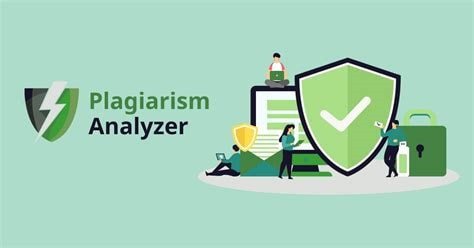A plagiarism analyzer is a tool or software designed to detect and analyze instances of plagiarism within written content. It compares the text being analyzed against a database of existing documents, academic papers, articles, and online content to identify similarities and potential instances of copied or unoriginal content. Here's a comprehensive summary of a plagiarism analyzer:
Plagiarism Analyzer Summary
1. Functionality
- Text Comparison: Analyzes the text being examined and compares it with a vast database of sources to identify similarities and matches.
- Originality Assessment: Determines the originality of the text by highlighting copied or paraphrased content and indicating the extent of similarity.
- Cross-Referencing: Checks against academic databases, internet sources, and proprietary databases to identify potential sources of plagiarism.
- Citation Analysis: Identifies and verifies citations and references within the text to ensure proper attribution of sources.
- Reports and Feedback: Generates detailed reports highlighting instances of plagiarism and provides feedback to users on how to improve originality.
2. Detection Methods
- Text Matching Algorithms: Utilizes algorithms such as string matching, fingerprinting, and lexical analysis to identify similarities between text segments.
- Database Searches: Scans through online repositories, academic databases, and web pages to compare the submitted text against existing content.
- Citation Analysis: Checks for proper citation formats and cross-references citations to verify the accuracy of attributions.
- Machine Learning: Incorporates machine learning and natural language processing techniques to enhance detection accuracy and adapt to evolving plagiarism patterns.
3. Features and Tools
- Real-Time Analysis: Provides instant feedback on the originality of content during the writing process, helping users avoid unintentional plagiarism.
- Document Upload: Allows users to upload documents or text files for analysis, with support for various file formats.
- Bulk Checking: Offers the ability to check multiple documents or batches of text simultaneously for plagiarism.
- Interactive Reports: Presents results in user-friendly formats, with interactive reports highlighting matched sources and similarity percentages.
- Integration: Integrates with writing platforms, learning management systems, and document management tools for seamless integration into existing workflows.
4. User Benefits
- Maintains Academic Integrity: Helps students, researchers, and educators uphold academic integrity by detecting and preventing plagiarism.
- Saves Time: Streamlines the process of checking for plagiarism, allowing users to quickly identify potential issues and make necessary revisions.
- Promotes Originality: Encourages original thinking and writing by highlighting instances of similarity and providing feedback on improving originality.
- Ensures Compliance: Assists organizations and businesses in ensuring compliance with copyright laws and ethical standards in content creation.
- Improves Writing Skills: Provides constructive feedback on writing style, citation practices, and attribution, supporting skill development and improvement.
5. Challenges
- False Positives: Some tools may produce false positives, flagging legitimate content as plagiarized due to common phrases or citation overlap.
- Database Coverage: The effectiveness of detection depends on the size and quality of the database used for comparison, with some tools having limited coverage.
- Paraphrasing Detection: Detecting paraphrased content can be challenging, as it may not match directly but still constitutes plagiarism.
- Multilingual Support: Ensuring accurate detection across multiple languages and cultural contexts presents challenges for global users.
- Data Privacy: Addressing concerns related to data privacy and security, particularly when uploading sensitive or confidential documents for analysis.
6. Future Trends
- Enhanced AI Capabilities: Continued advancements in artificial intelligence and machine learning to improve detection accuracy and reduce false positives.
- Multimodal Analysis: Incorporation of multimodal analysis techniques, including image and multimedia content analysis, to detect plagiarism across diverse content types.
- Blockchain Integration: Integration of blockchain technology for secure and immutable record-keeping of plagiarism checks and originality verification.
- Customization and Personalization: Offering personalized feedback and recommendations based on user preferences, writing style, and academic discipline.
- Global Collaboration: Collaboration among academic institutions, publishers, and technology providers to develop standardized approaches to plagiarism detection and prevention.
Example of a Plagiarism Analyzer
Use Case: Academic Writing
- Student Submission: A student submits an essay to their professor using an online plagiarism analyzer integrated into the learning management system.
- Analysis Process: The tool scans the submitted essay against a comprehensive database of academic papers, journals, and web sources.
- Detection Report: The tool generates a detailed report highlighting any instances of similarity, providing links to the matched sources, and indicating the percentage of similarity.
- Feedback and Revision: Based on the analysis report, the student receives feedback on areas of concern and is prompted to revise and improve their work before final submission.
Platform: Turnitin
- Functionality: Offers comprehensive plagiarism detection and originality checking services for academic institutions, with features for document upload, real-time analysis, and similarity reports.
- User Benefits: Helps educators promote academic integrity, supports student learning and skill development, and ensures compliance with academic standards and regulations.
 English
English
 العربية
العربية
 中文語言
中文語言
 हिंदी भाषा
हिंदी भाषा
 हespañol
हespañol
 русский
русский
 Português
Português
 Le français
Le français
 Deutsch
Deutsch
 ภาษาไทย
ภาษาไทย
 Português
Português


Comments
Muchas gracias. ?Como puedo iniciar sesion?
Add New Comment